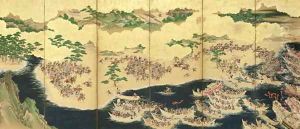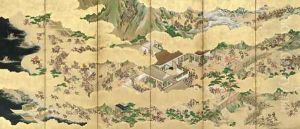Yusetsu Kaiho Paintings
Yusetsu Kaiho was a Japanese painter who lived during the Azuchi-Momoyama period, a time characterized by political unification under strong daimyo leaders such as Oda Nobunaga, Toyotomi Hideyoshi, and Tokugawa Ieyasu. This period was also remarkable for its cultural innovation and the development of a distinctively opulent and robust art style.
Yusetsu Kaiho's exact birthplace is not well-documented, but he is known to have been active in the late 16th and early 17th centuries. His work was heavily influenced by the prevailing style of the Kano school, the leading school of Japanese painting commissioned by the ruling class for decorating castles and villas. The Kano school, founded by Kano Masanobu and continued by his son Kano Motonobu, championed a style blending the formal elegance of Chinese painting with a more decorative Japanese aesthetic.
Kaiho Yusetsu, also known as Kaiho Yusho, contributed to the legacy of the Kano school, although he is not as well-known as some of his contemporaries. He was noted for his skill in both ink and color painting, creating works that were in demand among the elite of Japanese society. His paintings often contained Zen Buddhist themes, reflecting the spiritual teachings and philosophies that were prevalent among educated circles of the time.
Yusetsu's work is characterized by its dynamic brushwork and the use of vivid colors. Although much of his work has not survived to the present day, the pieces that remain show a mastery of the techniques of the Kano school and provide valuable insight into the aesthetic preferences and cultural milieu of the Azuchi-Momoyama period.
Yusetsu Kaiho passed away in 1615, leaving behind a body of work that would influence the trajectory of Japanese painting. His contributions to the arts during a transformative period in Japan's history ensured that his name, though not as prominent as some of his peers, would be remembered in the annals of Japanese art history.

